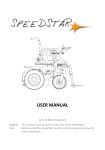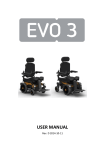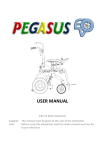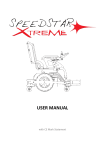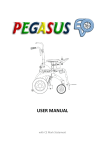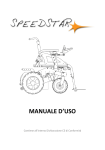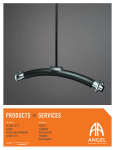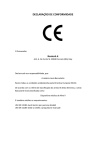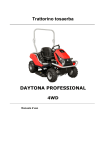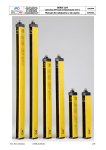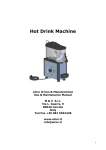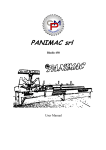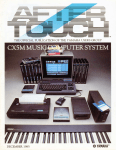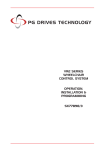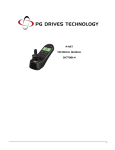Download SERVICE MANUAL
Transcript
SERVICE MANUAL Rev D 2014-10-11 DECLARATION OF CONFORMITY The manufacturer Neatech.it 4/A, A. de Curtis, 80040, Cercola (NA), Italy under its responsibility, states that the wheelchair EVO3 satisfies the conditions laid down by the European Directive 93/42 and its subsequent updates; according to the criteria for classification of Annex IX of this directive, the EVO3 is classified as class I medical device It also complies with the requirement of the harmonized standards: UNI EN 12182 – Technical aids for disabled person UNI EN 12184 – Electrically powered wheelchairs, scooters and their chargers 1 WHEELCHAIR PRESENTATION................................................................................................. 9 2 USER INFORMATION ............................................................................................................. 10 2.1 Warnings ........................................................................................................................ 10 2.2 Checks to be made on delivery ..................................................................................... 12 2.3 Unpacking ...................................................................................................................... 12 2.3.1 Remove the EVO3 from the pallet ......................................................................... 13 2.4 Assembly operation ....................................................................................................... 13 2.5 Transport and storage ................................................................................................... 13 2.6 ADJUSTMENTS ............................................................................................................... 14 2.6.1 Armrests ................................................................................................................. 14 2.6.2 Legrest .................................................................................................................... 15 2.6.3 Backrest .................................................................................................................. 18 2.6.4 Seat depth............................................................................................................... 18 2.6.5 Drive profile ............................................................................................................ 19 2.7 USE OF THE WHEELCHAIR ............................................................................................. 20 2.7.1 Rnet control console............................................................................................... 20 2.7.2 Using the wheelchair .............................................................................................. 22 2.7.3 Manual brake release lever .................................................................................... 25 2.7.4 Powered function ................................................................................................... 26 2.7.5 Battery charging ..................................................................................................... 28 2.7.6 Use as seat in motor vehicle ................................................................................... 30 2.8 MAINTENANCE .............................................................................................................. 32 2.8.1 Tire puncture .......................................................................................................... 33 2.8.2 Checks to be made on the wheelchair ................................................................... 34 2.8.3 Troubleshooting ..................................................................................................... 34 2.9 2.10 Spare part list ................................................................................................................. 37 Instruction for replacing parts ................................................................................... 39 2.10.1 Antitip castor .......................................................................................................... 39 2.10.2 Front cover.............................................................................................................. 39 2.10.3 Back cover ............................................................................................................... 40 2.10.4 Legrest cover .......................................................................................................... 40 2.10.5 Backrest cover ........................................................................................................ 41 2.10.6 Tire of traction (with tube) ..................................................................................... 41 2.10.7 Tire of castor wheel (with tube) ............................................................................. 42 2.10.8 Armrest pad ............................................................................................................ 43 2.10.9 Joystick .................................................................................................................... 43 3 4 2.10.10 Seat cushion ........................................................................................................ 43 2.10.11 Backrest cushion ................................................................................................. 43 Instructions for replacing parts ............................................................................................ 44 3.1 Backrest actuator........................................................................................................... 44 3.2 Legrest actuator ............................................................................................................. 45 3.3 Lateral cover .................................................................................................................. 46 3.4 Traction wheel ............................................................................................................... 47 3.5 Castor wheel .................................................................................................................. 47 3.6 Motor ............................................................................................................................. 48 3.7 Armrest .......................................................................................................................... 49 3.8 Battery replacement ...................................................................................................... 50 3.9 Light on traction wheel .................................................................................................. 53 3.10 Light on castor wheel ................................................................................................. 54 3.11 Joystick support.......................................................................................................... 55 3.12 Power module ............................................................................................................ 57 3.13 Light module .............................................................................................................. 58 3.14 Seating module .......................................................................................................... 59 3.15 Advanced Seating module ......................................................................................... 61 3.16 Footplate .................................................................................................................... 63 3.17 Complete legrest ........................................................................................................ 64 3.18 Legrest belt................................................................................................................. 65 3.19 Cables ......................................................................................................................... 66 Maintenance ......................................................................................................................... 67 4.1 5 Punctured wheels .......................................................................................................... 67 Electronics maintenance ...................................................................................................... 68 5.1 Hardware ....................................................................................................................... 68 5.2 Wiring diagram .............................................................................................................. 69 5.3 Software......................................................................................................................... 71 5.3.1 6 5.4 Software of Rnet system – changing parameters ......................................................... 75 5.5 Electronic Troubleshooting ........................................................................................... 83 5.6 Rnet system fault ........................................................................................................... 83 5.7 Magneto hydraulic protection....................................................................................... 88 Specifications ........................................................................................................................ 89 6.1 7 Software of the Rnet System – On Board Programming........................................ 72 Dimensions .................................................................................................................... 90 WARRANTY TERMS ............................................................................................................... 91 7.1 SERIAL NUMBER ............................................................................................................ 91 7.2 INCIDENT REPORTING.................................................................................................... 91 Service manual is intended for technical personnel to maintain and repair wheelchairs. It is important to follow the instructions contained in this manual in order to professionally work with the wheelchair. The qualified personnel who works with wheelchairs must comply with all provisions of occupational safety and common sense in order to preserve his own safety. The manufacturer declines all responsibility for any accidents occurring during the working with wheelchairs MODIFICATIONS Any unauthorized modifications to the wheelchair may increase the risk of personal injury and damage to the wheelchair. All modifications should be done by an authorized service center. Do not use any unauthorized accessories or spare parts on the wheelchair. Do not use the wheelchair in combination with other medical devices without first having considered any risk due to combination of more product. MANUFACTURER For any need not expressly explained in this manual, please contact the manufacturer. Neatech.it 4/A, A. de Curtis, 80040, Cercola (NA), Italy www.neatech.it – [email protected] - +39 081 555 1946 DISPOSING This product and all its components can not be treated as household waste. For more detailed information on how recycling and disposal this product contact your local waste disposal service. 1 WHEELCHAIR PRESENTATION Thank you for purchasing EVO3 electronic wheelchair. EVO3 is a battery powered wheelchair. Its intended use is to provide indoor mobility to person limited to seated position that are capable to operate and drive an electronic wheelchair. Though EVO3 was designed to be used mainly indoors it is possible to have lights and to use the wheelchair even in some outdoor environments. Motors 2x 220 W Batteries 2x55Ah 12V Electronic Tilt (45°) + Electronic Negative Tilt (45°) Electronic Lift (30 cm) Electronic Reclining Backrest (0-170°) Electronic Elevating Central Mounted Footrest WARNING: It is prohibited to use wheelchair or its parts for any purpose other than that indicated. For a correct use please follow the instructions given in this manual. NEATECH.IT disclaims any responsibility for damages caused by improper use of aids. The information in this manual may be subject to change without notice. All information, pictures and specifications are based upon the product information that was available at the time of printing. They are representative examples and not intended to be exactly as the actual wheelchair www.neatech.it 9 2 USER INFORMATION 2.1 Warnings TIPPING HAZARD Any transport on a slope greater than the maximum security slope can be dangerous. ELECTROMAGNETIC RADIATION DANGER The behavior of the wheelchair while driving may be affected by electromagnetic fields created by transceivers such as: Citizens band (CB) radios, walkie-talkies, fire and police radios, cellular phones, lap-top computers, two-way radios, and commercial radio and television broadcast antennas. PLEASE USE CAUTION in the presence of these devices. EMI can cause your chair, without warning, to: • Release its brakes • Move by itself • Move in unintended directions If any of these occur, it could result in severe injury to you or others. EMI can damage the control system of your chair. There is no way to know the effect on EMI if you add accessories or modify this chair. Any change to your chair may increase the risk of EMI. Parts from other suppliers have unknown EMI properties. The wheelchair might disturb the operation of devices in its environment that emit electromagnetic fields TEMPERATURE The temperature of some surfaces may increase when the chair is exposed to external heat sources as sunlight. Do not install, maintain or operate your wheelchair without reading all warnings and this entire user’s manual. Always keep this manual in connection with your wheelchair. NOTICE TO RIDER—WARNING Do not use your wheelchair on stairs or escalators. Do not lift or move the wheelchair by any of its removable parts. The wheelchair should be turned off prior to entering or exiting the wheelchair The wheelchair may come to a sudden stop at any time during operation. Do not operate the wheelchair if it is behaving abnormally or erratically. Do not operate the wheelchair with low batteries, to minimize risk of becoming stranded. Don’t use the wheelchair if your weight exceed the maximum user weight written in the specification of this user manual. Do not carry passengers on the wheelchair independently of the age of the passenger www.neatech.it 10 PINCH HAZARDS – WARNING Make sure your feet do not “hang up” or get caught in the space between the footrests. In general, make sure you have proper space in areas you will travel through to minimize pinching or entrapment of body parts. Do not use an escalator to move the wheelchair between floors. Serious bodily injury may occur. Do not lean over the top of the back upholstery to reach objects from behind as this may cause the wheelchair to tip over. Do not shift your weight or sitting position toward the direction you are reaching as the wheelchair may tip over backwards or sideways Do not tip or wheel the wheelchair with wheel locks. Wheel locks are not brakes. Do not stand on the frame of the wheelchair. Always use caution when transferring in or out of the wheelchair. Every precaution should be taken to reduce the transfer distance. Also be certain the wheel locks are engaged to prevent the wheels from moving. Caution—Obstacles Riding over curbs or obstacles can cause tipping and serious bodily harm. If you have any doubt that you can safely cross any curb or obstacle, ALWAYS ASK FOR HELP. Be aware of your riding skills and personal limitations. Develop new driving skills only with the help of a companion. Caution—Anti-Tippers Using anti-tippers substantially reduces your risk of falling over backwards, which can cause serious injury. The Anti-Tippers will keep you from falling over, but they will limit your ability to be pulled up curbs and some other maneuvers. IT IS NOT POSSIBLE TO HAVE THIS WHEELCHAIR WITHOUT ANTI TIPPERS. The wheelchair is not designed for weight training and is unsafe for use as a seat while weight training. Weight training from the wheelchair substantially changes the stability of the chair and cause tipping. The wheelchair is not intended to be dismantled. There is no parts of the wheelchair expected to be handled during normal use of it. LIGHTS It is recommended to not use the wheelchair near public way without lights turned on. www.neatech.it 11 2.2 Checks to be made on delivery Check for the integrity of the original packaging. Check for any anomalies on the shipping documents. Check for the functionality and integrity of the device in all its parts, at the time of delivery or immediately thereafter, to ensure that no damage has resulted from a careless transport. Make sure the surface of the device is not damaged, scratched, bent, etc. Any fault or damage found must be immediately reported on the shipping documents and promptly communicated to the carrier. For any other questions, please contact the manufacturer. 2.3 Unpacking Be sure to put the package of the EVO3 on a stable and secure surface and remove straps with scissors. Pull away the box as shown in Figure 1. Figure 1 Inside the box there is: EVO3 wheelchair N. 1 Charger Documentation and manuals www.neatech.it 12 2.3.1 Remove the EVO3 from the pallet Figure 2 Figure 3 Unlock the engine with the lever on the left and right side as shown in Figure 2 and Figure 3 and slide gently down the EVO3 from the pallet. After positioning the EVO3 in a safe place, return the lever to its original position. PACKAGING DIASPOSAL To properly recycle the packaging materials follow the instructions provided by your local waste disposal service. 2.4 Assembly operation Mount the backrest on the wheelchair as it is described in section 2.6 - ADJUSTMENTS. 2.5 Transport and storage If you do not use your EVO3 for a long time make sure that you set the switch OFF as shown in Figure 4. You should keep the EVO3 in a place free from dust and moisture and away from heat sources. If you need to transport the EVO3, turn off the switch. For the transport be sure that the vehicle is approved for this purpose and set the brake release levers in right position (UP, brakes engaged) The wheelchair isn’t intended to be dismantled for storage or transport. Figure 4 www.neatech.it 13 2.6 ADJUSTMENTS EVO 3 wheelchair has the possibility of many adjustments to best suit the specific user. To perform these adjustments they are required a 4 mm allen wrench, a 5 mm allen wrench and a 8 mm open-end wrench. These adjustments can be made by the vendor or by an assistant of the user. 2.6.1 Armrests The available adjustment are in height and angle; these need to be made on the same order as they are presented. For the armrest height loosen the four bolts shown in Figure 5 and adjust the height with the single bolt located upon the support shown in Figure 6. For this operation use the 5 mm allen wrench Figure 5 Figure 6 For the armrest angle, you can decide to adjust the horizontal and vertical angle. www.neatech.it 14 For the horizontal angle, lift the armrest that you want to modify and unscrew the bolt indicated in Figure 7; after this you can set the right armrest angle, screwing the bolt to fixing the correct angle. For this operation use the 4 mm allen wrench Figure 7 For the vertical angle rotate clockwise the screw shown in Figure 8 to lower the armrest, rotate counterclockwise the screw to let up the armrest. Figure 8 2.6.2 Legrest Height To adjust the legrest height, remove the cover (Figure 9) and loosen the bolts shown in Figure 10 with the 4 mm allen wrench; Figure 9 www.neatech.it 15 Figure 10 It is possible to adjust separately the height of right and left footrest. After loosen the bolts you can adjust the height of footrest, moving it up or down. To move it down it is required to push it towards the chassis and that push it down as it is shown in the Figure 11. After this adjustment you have to screw again the bolts loosen to fix the legrest position. Figure 11 www.neatech.it 16 Footrest width and angle You can adjust separately right and left paddle. Loosening two bolts for one paddle as shown in Figure 12 (with the 4 mm allen wrench) you can move it in the chosen position as shown in Figure 13. Figure 12 Figure 13 Loosening the bolt shown in Figure 14 (with the 4 mm allen wrench), under the paddle, it is possible to modify the angle of paddle. Figure 14 www.neatech.it 17 2.6.3 Backrest To perform the adjustment of the backrest for different type of height, you have to screw off the nuts positioned over the four different bolts as it is possible to see in Figure 15. To screw off the nuts, it is necessary an 8 mm open-end wrench. Figure 15 After screwed off the nuts it is possible to adjust the height. To facilitate the mounting of the backrest up the support it may be useful to remove the upholstery of the backrest. 2.6.4 Seat depth To adjust the seat depth, loosen the 6 bolts on the right side and the 3 bolts on the left side of the seat, as it is shown in Figure 16. Figure 16 In this way one can move forward and backward the seat. When the chosen position is reached it is necessary to screw again the bolts. Figure 17 www.neatech.it 18 2.6.5 Drive profile As default in the wheelchair they are saved some different drive profile for the use indoor and outdoor. Additional profiles should be the result of customization for the individual user. Use the button “PROFILE” of the joystick to change different types of profiles: they are sorted from the more indoor one to the more outdoor one. For each profiles it is possible to change the speed. INDOOR PROFILES When this profile is activated most of the parameters of the wheelchair are cut off. For example the maximum speed and the acceleration are limited. In this way the handling is really improved and there is more margin for mistake on the lever of the joystick. In this way it is comfortable to use the wheelchair in indoor environments. OUTDOOR PROFILES When this profile is activated most of the parameters of the wheelchair are at the maximum value. For example the maximum speed and the acceleration are not limited. In this way it is comfortable to use the wheelchair in outdoor environments. However remember that the wheelchair EVO3 was designed for use mostly in indoor environments. www.neatech.it 19 2.7 USE OF THE WHEELCHAIR 2.7.1 Rnet control console The user interface is a joystick with a lever, buttons and a display. Figure 18 For the use of joystick please refer to the following instructions. Figure 19 www.neatech.it 20 This button turns on and off the wheelchair. Don’t use this button to stop the wheelchair unless it is an emergency. On-Off Button When this button is pressed the horn will sound Horn Button This button allow the user to navigate through the available function of the wheelchair (drive, actuators, preloaded movements) Mode Button This button allow the user to navigate through the available driving profiles for the wheelchair Profile Button These buttons decrease/increase the maximum speed setting Speed Buttons This button activates and deactivates the wheelchair’s hazard lights. When activated the Led will flash. Hazard Button + Led This button activates and deactivates the wheelchair’s lights. When activated the Led will illuminate Lights Button + Led Left-Right Indicator Button + Led These buttons activates and deactivates the wheelchair’s indicators. When activated the Led will flash Use the controller of the joystick to get in gear. Its proportional functionality allows you to adjust speed and direction according to the intensity with which you act on the controller. Releasing the lever of the controller automatically activates the electromagnetic brake that locks the wheels of the EVO3. BATTERY INDICATOR SPEED INDICATOR TIME SPEED LIMIT INDICATOR PROFILE IN USE Figure 20 www.neatech.it 21 The installation menu allows the user to access a range of setting: Set Time Display Time Distance Backlight Background A right joystick inclination will enter the menu for the clock adjustment Left and right the joystick to change between 12h, 24h, off You can enter a screen where you can see the total distance driven using the wheelchair, the distance driven from last reset and you can reset this distance You can adjust the intensity of the LCD screen from 0 to 100 % in step of 10% You can choose the color of the background of the LCD screen between blue and white. Exit this menu Exit 2.7.2 Using the wheelchair Do not drive your wheelchair for the first time without the presence of an assistant near to you. At the beginning always use the INDOOR profile. Do not let children use the wheelchair without supervision. Do not drive your wheelchair under the influence of alcohol. Some pathologies may limit your ability to drive your wheelchair safely. Be sure to consult with a doctor about your physical limitations. Avoid sudden stops or starts. To stop the wheelchair use the lever of the joystick and don’t suddenly turn off the joystick. Don’t turn the wheelchair at high speed. When driving downhill, select the slowest speed. When driving uphill, try to keep moving at a stable speed. Anyway avoid driving on ramps without any edge protection. Do not drive up or down slopes with a slope greater than one indicated in the technical specifications of this manual. Center of balance of the wheelchair and so its stability cab be affected by: Lifting of the seat User position Us of a backpack Tilting of the seat WARNING If your wheelchair begins to behave in an unexpected manner, immediately release the joystick to stop the wheelchair and turn it off. www.neatech.it 22 DEFAULT POSITION Default position mean a safe position for the seat system of the wheelchair: o Height of the seat = 0 cm o Angle of seat = 0° o Angle of legrest = 90° o Angle of backrest = 90° Obstacle climbing When facing with an obstacle it is recommended to set the position of the seat in the “default position”. In order to riding over higher obstacles it is strongly recommended to take a run up of almost 500 mm when facing the obstacle first with castors. Dealing with uphill When facing an uphill road it is recommended to set the position of the seat in the “default position”. In order to best come over an uphill it is strongly recommended to use an outdoor profile at maximum speed with the wheelchair facing forward. WARNING Stopping and starting the chair while moving up an incline makes the wheelchair more difficult to control Dealing with downhill When facing a downhill road it is recommended to set the position of the seat in the “default position”. In order to best come over a downhill it is strongly recommended to use an indoor profile at minimum speed with the wheelchair facing forward. WARNING Don’t drive up or down slopes with a gradient than indicated in section 6. WARNING Don’t drive up or down ramps that are not equipped with proper edge protection to prevent the wheelchair from falling down WARNING Don’t drive down or up a hazardous incline if the surface is covered with snow, ice or the surface is uneven. www.neatech.it 23 Driving on side slopes When facing with side slopes, always drive the wheelchair with great caution and at minimum speed Turning with the wheelchair Don’t turn with the wheelchair at high speed. Driving in dark environments Driving in dark environments can only be done if the wheelchair has functioning lights DRIVE WITH SEAT SYSTEM NOT IN DEFAULT POSITION Operating seat lift, tilt, backrest recline and legrest elevation may change the center of gravity and increase the risk of tipping over. Always drive in low speed and only use these functions on level surface. Safety belt Evo3 wheelchair has the predisposition for a pelvic belt, that can be purchased as an accessory. Pelvic belt is only designed to position the user and not for any protection in case of accident Transfer into and out the wheelchair Before entering or leaving the wheelchair turn it OFF. Users transfer is recommended with the assistance of an attendant. Don’t use the joystick as a handhold or point of support. Don’t use footrests or armrests as support. Joystick Error If the joystick is moved from the central position during or immediately after turning on an error will be displayed, see Figure 21. To enable the wheelchair to drive again set the joystick in the central position and reboot the wheelchair. Figure 21 www.neatech.it 24 2.7.3 Manual brake release lever In case of necessity it is possible to manually move the wheelchair. First of all you have to turn off the wheelchair acting on the specific button of the joystick. Then you can act on the release lever shown in Figure 22 and Figure 23. When the brakes are released, it is not be possible to drive the wheelchair. Figure 22 Figure 23 WARNING When the brakes are released never use the wheelchair on a slope or a wet surface. Don’t operate the brake release without the presence of an assistant www.neatech.it 25 2.7.4 Powered function Depending on the configuration of your own EVO3 some of this function should be not available or different. WARNING Operating these functions changes the center of gravity and increases the risk of tipping over. Always drive in low speed and only use these functions on horizontal plane. Seat lift Figure 24 A maximum lift of 30 cm allows the user to have more independence. Seat tilt Adjusting the tilt of the wheelchair (45°) causes a better distribution of pressure on the body of the user. This helps to reduce the incidence of all problems due to punctual localization of loads. Moreover tilting helps you to avoid retention of fluids in the lower leg, make it easier to sit on the wheelchair. As a consequence even legrest will be raised while tilting, so you can better pass some obstacles. Figure 25 www.neatech.it 26 Backrest biomechanical recline Figure 26 Powered reclining of the backrest (range 90°-170°) helps to improve the posture. It is also useful to facilitate personal care. To best fit physiological movement as the backrest recline, it also slides down. The point of rotation of the backrest can’t coincide with the human’s anatomical point of rotation of the back. The biomechanical reclining is the best way to solve this and make the backrest and the headrest to remain in the same position in relation to the back. Legrest biomechanical elevation A central mounted legrest takes up less space than separated legrest making it easier to move with the wheelchair. In this way even lateral transfer will be easier. The knee that is the point of rotation of the lower leg can’t coincide with the point of rotation for the elevation of the footrest. EVO3 legrest has an innovative way to compensate this and assure that the knee and the thighs remain firmly on the wheelchair. Figure 27 www.neatech.it 27 2.7.5 Battery charging To recharge the batteries use only the provided charger or one recommended by Neatech.it. The manufacturer is not responsible for damage to person or property resulting from the use of non-original product. For a list of recommended charger please contact your vendor. Connect the power cord to a power supply 230 V. Connect the cable to the joystick as shown in Figure 28 and Figure 29. Figure 28 Figure 29 When batteries are loaded unplug the power cord and the battery cable. Battery charging should be done in well ventilated environments. Never charge in bathroom or wet room. When the charger is connected it is not possible to drive the wheelchair Each battery is subject to a normal “self-discharge”, so batteries that are not used for long time will discharge by itself. Charging time is influenced by multiple factors such as remaining battery power, battery state of aging and temperature. However the approximate charging time is about 7-9 hours. If the charge duration was reduced (about 1 hour), that is a sign of failure: contact the vendor for a possible replacement of batteries. Don’t use the wheelchair during the charge. www.neatech.it 28 SHOCK HAZARD Check if charger data sheet matches with the network power (voltage, frequency). Only use the charger supplied with the wheelchair. RELEASE DANGER Any impact to the batteries could cause a loss of fluids. Pay attention ENVIRONMENTAL HAZARD It is recommended to properly recycle used batteries. Contact your local agency for waste disposal for more information. www.neatech.it 29 2.7.6 Use as seat in motor vehicle Hooks for local travel (four-point tie-down) The wheelchair was tested when used as a front-facing seat in a motor vehicle, meeting the requirements of ISO 7176-19 The way of access to the motor vehicle and handling within it is influenced by the size of the wheelchair. For a safe use of the wheelchair as a seat in a motor vehicle please follow this instructions: It is recommended to use the pelvic seat belt along the front of the pelvic area, so that the angle of the belt is between 30° and 75° from the horizontal, as shown in Figure 30; a greater angle, always in the expected range, is preferable. Figure 30 You should keep your seat belts as tight as possible to the body, but without affecting the comfort Make sure that the belts are not twisted during use. It is recommended to use both the pelvic belt and the shoulder belt to reduce the possibility of impact of the head and chest with vehicle components. Figure 31 www.neatech.it 30 Remove and assure inside the vehicle any accessory from the wheelchair in order to reduce the potential risk of injury. If the wheelchair has been involved in some type of collision between vehicles, it must be tested by the manufacturer before re-use. Don’t make any alteration or tampering on point of safety or structural parts. Use extreme care when positioning the wheelchair, so that the release button of the seat belt can not be pressed by its components in case of impact. The hooks that can be used with the wheelchair are “Four-Point Tie-Down” type. The wheelchair will be hooked up inside the motor vehicle in 4 points: 2 front and 2 rear, as shown in Figure 32. Figure 32 Don’t use any postural support in a motor vehicle unless they are conform to ISO 7176-19. www.neatech.it 31 2.8 MAINTENANCE Regular maintenance help to preserve functionality and safety of the Evo3. The lack or inadequacy of care and maintenance implies a limitation of the warranty from the manufacturer. To clean the chair don’t use any device to spray water at high pressure and in any case protect the control device from water and humidity. For plastic or metal parts use a soft cloth moistened with a non-aggressive detergent. For pads, linings and covers of the seat and backrest use warm water and mild detergent. Do not use chemical cleaners, solvents, acids, etc. Tires can be cleaned with water and detergent. CAUTION All interventions in the wheelchair’s systems must be performed by an authorized service center SHOCK HAZARD The main switch must always be switched off when batteries are replaced or you are doing any maintenance of the wheelchair. Always turn off the joystick before interrupting the power with the main switch. www.neatech.it 32 2.8.1 Tire puncture In case of tire puncture please see following instruction: CASTERS PUNCTURE Disassemble the punctured caster unscrewing the bolt shown in Figure 33 by locking the nut (1) with an open-end wrench of 13 mm and unscrew the bolt (2) with an allen wrench of 6 mm. 2 1 Figure 33 Contact an authorized service center to repair the punctured wheel. TRACTION WHEELS PUNCTURE Disassemble the punctured wheel unscrewing the four bolts indicated in Figure 34. Figure 34 Pay attention when unscrewing the bolts and pulling away the wheel because in case of incorrect procedure it is possible to damage the hub motor. Contact an authorized service center to repair the punctured wheel. www.neatech.it 33 2.8.2 Checks to be made on the wheelchair CHECK Battery charge level Electric cables obstacle Tightening of removable parts PERIOD NOTE Before each utilize Check the battery charge level on the indicator located on the joystick. (see Figure 20) Before each utilize Check that the wires do not interface with the movements of the wheelchair. Before each utilize Ensure all removable parts are securely locked in place. Verify that the tire pressure is consistent with the given values: Tire pressure Weekly Lights check Weekly Cleaning of wheelchair Brake release lever check Tire usury Checking tightness of chassis screws DRIVE WHEELS: 280 kPa CASTOR WHEELS: 250 kPA Overfilling can cause a risk of explosion Verify that all lights and indicators work properly and are clean. This point can apply only if you have lights on your wheelchair Monty Clean the wheelchair and the upholstery according to the instructions of this manual Monty Check that the brake release is working properly Monty Check for the tire usury and if necessary contact your vendor for the replacement Annual For this operation please contact an authorized service center 2.8.3 Troubleshooting EVENT The wheelchair can not be started POSSIBLE CAUSE Batteries discharged Joystick cable not connected or badly connected Main switch is set to OFF The wheelchair is turned on but the chair does not drive The wheelchair stops while driving The wheelchair can only be driven at low speed Batteries in charging Brake release lever in wrong position Magneto – hydraulic protection switch has triggered Joystick cable not connected or badly connected Seat lift is too high or anyway the position of the seat is such that the speed need to be limited for safety reasons Wheelchair makes noise Release lever not properly inserted Tire puncture Tire puncture Problems with the seat system Broken actuator or software fault www.neatech.it 34 REMEDY Charge the batteries Properly insert the joystick cable Turn the main switch to ON. If the problem continues, it means that there are some electric problems. Please don’t use your wheelchair and contact an authorized service center Wait that the batteries are completed charged Set properly the brake release lever as it is shown in section 2.7.3 Turn the main switch to ON. If the problem continues, it means that there are some electric problems. Please don’t use your wheelchair and contact a qualified technician Properly insert the joystick cable Adjust the position of the seat Insert the release lever correctly as it is shown in section 2.7.3 See section 2.8.1 Contact an authorized service center Rnet system fault When the control system is triggered and the wheelchair can’t be used, a diagnostic screen is displayed in the display of the joystick. First switch off the wheelchair and leave it off for some minutes. Then reboot the wheelchair. If the fault still continues, contact an authorized service center. Figure 35 Seeing Figure 35: Identified Module indicates the module that had the problem For example: PM Power Module JSM Joystick ISM Light Module CxSM Seating Module The Trip Text is a brief description of the problem The Trip Code is a four digit code that allow an authorized service center to identify the problem For any other need, please contact the manufacturer. www.neatech.it 35 www.neatech.it 36 2.9 Spare part list Code R042-001 R042-002 R042-003 R042-004 R042-005 R042-006 R042-007 R042-008 R042-009 R042-010 R042-011 R042-012 R042-013 R042-014 R042-015 R042-016 R042-017 R042-018 R042-019 R042-020 R042-021 R042-022 R042-023 R042-024 R042-025 R042-026 R042-027 R042-028 R042-029 R042-030 R042-031 R042-032 R042-033 R042-034 R042-035 R042-036 R042-037 R042-038 R042-039 R042-040 Description Antitip castor Backrest actuator Legrest actuator Front cover Rh cover Lh cover Back cover Legrest cover Backrest cover Traction wheel Tire of traction wheel (with tube) Castor wheel Tire of castor wheel (with tube) Rh motor Lh motor Armrest pad Rh armrest (with bracket) Lh armrest (with bracket) Battery set Charger Light on traction wheel Light on castor wheels Joystick Rh joystick support Lh joystick support Power module Light module Seating module Advanced seating module Footplate Complete legrest Legrest belt Rnet cable 2.5 m Rnet cable 1.5 m Rnet cable 0.5 m Rnet cable 1.0 m Actuator cable Advanced seating module cable Seat cushion Backrest cushion www.neatech.it 37 Type of service A B B A B B A A A B A B A B B A B B B A B B A B B B B B B B B B B B B B B B A A Note Specify the width of the wheelchair Type of service A B Code Parts that the final user can buy at an authorized service center and substitute by himself. Parts that need the intervention of an authorized service center for the maintenance Use of unapproved aftermarket accessories and parts may make the wheelchair unstable or uncontrollable www.neatech.it 38 2.10 Instruction for replacing parts 2.10.1 Antitip castor Unscrew the screw indicated in Figure 36 using a PH2 star head screwdriver positioned from the internal side of the castor. Remove the castor. Figure 36 To mount the new part screw again the screw using the same tool still positioned from the internal side of the castor. 2.10.2 Front cover Unscrew the screws indicated in Figure 37 and remove the cover. For this operation use a 4 mm allen wrench. Figure 37 To mount the new part repeat the operations in reverse order. www.neatech.it 39 2.10.3 Back cover Unscrew the screws indicated in Figure 38 and remove the cover. For this operation use a 3 mm allen wrench. Figure 38 To mount the new part repeat the operations in reverse order. 2.10.4 Legrest cover Take the two lower side of the legrest cover and pull them out. Then you have to take two higher side of the cover and pull them out. In this way you are able to take away the legrest cover Figure 39 Figure 40 To mount the new part repeat the operations in reverse order. www.neatech.it 40 2.10.5 Backrest cover Remove the backrest cover first removing the lower part and then pulling it upward. Figure 41 To mount the new part repeat the operations in reverse order. 2.10.6 Tire of traction (with tube) Remove the screws (1) shown in Figure 42 and remove the wheel of traction. Then remove the screws (2) indicated in Figure 43 and take away the rim; after that it is possible to remove the tire with its tube. 1 Figure 42 2 Figure 43 To mount the new part repeat the operations in reverse order. www.neatech.it 41 2.10.7 Tire of castor wheel (with tube) Disassemble the castor unscrewing the bolt shown in Figure 44 by locking the nut (1) with an open-end wrench of 13 mm and unscrew the bolt (2) with an allen wrench of 6 mm. 2 1 Figure 44 Remove the screws (1) shown in Figure 45 and take away the rim; after that it is possible to remove the tire with its tube. 1 Figure 45 To mount the new part repeat the operations in reverse order. www.neatech.it 42 2.10.8 Armrest pad Unscrew the screws indicated in Figure 46 and substitute the armrest pad with a 4 mm allen wrench. Figure 46 To mount the new part repeat the operations in reverse order. 2.10.9 Joystick Switch off the wheelchair using the power button on the joystick, see Figure 19. Switch off the main circuit breaker, see section 5.6. Unplug the joystick cable. Unscrew the two screws below the joystick using a 3 mm allen wrench. Substitute the joystick, screw the two screws and plug the cable again. Ensure that the cable is properly connected. Figure 47 2.10.10 Seat cushion Remove the seat cushion pulling it up. Place the new cushion on the straps and ensure it is correctly got it right. Specify the width of the wheelchair. 2.10.11 Backrest cushion Remove the backrest cushion pulling it forward. Place the new cushion on the straps and ensure it is correctly got it right. Specify the width of the wheelchair. www.neatech.it 43 3 Instructions for replacing parts 3.1 Backrest actuator First assure that the wheelchair is on a level surface and it is at the default position (see section 2.7.2 ). If the wheelchair has any problem at the seating system for which it is not possible to reach the default position, please contact the manufacturer Remove the plastic cap form the actuator cable and unplug the cable. To remove the backrest actuator remove the parts (1), (2) and (3) shown in Figure 48 in this order and then take away the actuator 1 2 3 Figure 48 For the replacement use only parts supplied be the manufacturer Part number Description R042-002 Backrest actuator To mount the new part follow the instruction in reverse order. www.neatech.it 44 3.2 Legrest actuator First assure that the wheelchair is on a level surface and it is at the default position (see section 2.7.2 ). If the wheelchair has any problem at the seating system for which it is not possible to reach the default position, please contact the manufacturer Remove the seat cushion. Seeing Figure 49 remove the caps (1) and (2) and unscrew the 4 screws of the legrest beam. Sent the removed legrest to the manufacturer; it will be repaired and sent back to you. Pack the part that need to be substituted or repaired and contact the manufacturer to know the address of shipment. Pay special attention to the packaging in order to avoid any damage during the transport. Part number Description R042-003 Legrest actuator To mount the new part follow the instruction in reverse order. 1 2 Figure 49 www.neatech.it 45 3.3 Lateral cover First assure that the wheelchair is on a level surface and it is at the default position (see section 2.7.2 ). If the wheelchair has any problem at the seating system for which it is not possible to reach the default position, please contact the manufacturer First remove the traction wheel: chock up the wheelchair so that the wheel turns freely, unscrew the screw indicated in Figure 50 and remove the wheel. 1 Figure 50 Seeing Figure 51, remove the screws (1), (2) and (3) and remove the lateral cover. Part number Description R042-005 R042-006 Rh cover Lh cover To mount the new part follow the instruction in reverse order. 1 3 2 Figure 51 www.neatech.it 46 3.4 Traction wheel First assure that the wheelchair is on a level surface and it is at the default position (see section 2.7.2 ). If the wheelchair has any problem at the seating system for which it is not possible to reach the default position, please contact the manufacturer Chock up the wheelchair so that the wheel turns freely, unscrew the screw (1) indicated in Figure 52 and remove the wheel. 1 Figure 52 Part number Description R042-010 Traction wheel To mount the new part follow the instruction in reverse order. 3.5 Castor wheel First assure that the wheelchair is on a level surface and it is at the default position (see section 2.7.2 ). If the wheelchair has any problem at the seating system for which it is not possible to reach the default position, please contact the manufacturer Chock up the wheelchair so that the wheel turns freely. Seeing Figure 53, lock the nut (1) with an open-end wrench of 13 mm and unscrew the bolt (2) with an allen wrench of 6 mm. 2 1 Figure 53 Part number Description R042-013 Castor wheel To mount the new part follow the instruction in reverse order. www.neatech.it 47 3.6 Motor For the motor substitution it is necessary to send back the wheelchair to the manufacturer. Part number R042-014 R042-015 Description Rh Motor Lh Motor First assure that the wheelchair is on a level surface and it is at the default position (see section 2.7.2 ). Switch off the wheelchair and turn off the main circuit breaker, see section 5.6. Pack the wheelchair that need to be repaired and contact the manufacturer to know the address of shipment. Pay special attention to the packaging in order to avoid any damage during the transport. If the wheelchair has any problem at the seating system for which it is not possible to reach the default position, please contact the manufacturer www.neatech.it 48 3.7 Armrest First assure that the wheelchair is on a level surface and it is at the default position (see section 2.7.2 ). If the wheelchair has any problem at the seating system for which it is not possible to reach the default position, please contact the manufacturer Seeing Figure 54, unscrew the screw (1) and take away the armrest. 1 Figure 54 Part number R042-017 R042-018 Description Rh armrest Lh armrest To mount the new part follow the instruction in reverse order. www.neatech.it 49 3.8 Battery replacement Ensure that the wheelchair is on a level surface. Raise the legrest till the maximum elevation is reached. Lift the wheelchair at the maximum height. If the wheelchair has any problem at the seating system for which it is not possible to reach the desired position, please contact the manufacturer Seeing Figure 55, first switch off the main circuit breaker located under the front cover, then unscrew the screws indicated. Figure 55 Seeing Figure 56, remove the front cover and unscrew the indicated screw to unlock the battery case. Figure 56 www.neatech.it 50 Seeing Figure 57, remove the back cover unscrewing the screws indicated. Figure 57 Seeing Figure 58, unscrew the screws indicated and move upward the panel with electronic modules so that it doesn’t hinder with the movement of batteries. Figure 58 Pay special attention to the cables so that no connection is damaged during operation. If any connection damaged see section 0 for wiring information www.neatech.it 51 Pull the battery set till the first battery is out of the wheelchair chassis. Because of the weight of the battery set, at this point it is recommended to unscrew the screws indicated in Figure 59 and disconnect the wires in order to completely remove one battery. Then pull the other battery, disconnect the wires and take it away. Figure 59 Part number R042-019 Description Battery set To mount new batteries follow instructions in reverse order. For wires connection see Figure 60, there is also a label put on the battery set. Figure 60 Only after the new battery set is completely assembled, you can turn on the main circuit breaker. www.neatech.it 52 3.9 Light on traction wheel First assure that the wheelchair is on a level surface and it is at the default position (see section 2.7.2 ). If the wheelchair has any problem at the seating system for which it is not possible to reach the default position, please contact the manufacturer Remove the traction wheel as explained in section 3.4,then remove the screws (1) shown in Figure 61, unplug the cable and take away the plate and the fender in this order. Keep the plate in order mount again the fender. Contact the manufacturer to establish the extent of the damage and to decide if it is more convenient a repair or a complete replacement of the part. In case it is more convenient a repair sent the broken part to the manufacturer. Pack the part that need to be substituted or repaired and contact the manufacturer to know the address of shipment. Pay special attention to the packaging in order to avoid any damage during the transport. 1 Figure 61 To mount the new part follow the instruction in reverse order. Part number Description R042-021a Light on traction wheel for FWD wheelchair R042-021b Light on traction wheel for RWD wheelchair These light are front lights for FWD wheelchair and rear lights for RWD wheelchair. www.neatech.it 53 3.10 Light on castor wheel First assure that the wheelchair is on a level surface and it is at the default position (see section 2.7.2 ). If the wheelchair has any problem at the seating system for which it is not possible to reach the default position, please contact the manufacturer Seeing Figure 62, unscrew the bolt (1) and remove the two parts of the light case. Unplug the cable. Seeing Figure 63, unscrew the two bolt (1) and remove the light. 1 Figure 62 1 Figure 63 To mount the new part follow the instruction in reverse order. Part number Description R042-022a Light on castor wheel for FWD wheelchair R042-022b Light on castor wheel for RWD wheelchair These light are back lights for FWD wheelchair and front lights for RWD wheelchair. www.neatech.it 54 3.11 Joystick support First assure that the wheelchair is on a level surface and it is at the default position (see section 2.7.2 ). If the wheelchair has any problem at the seating system for which it is not possible to reach the default position, please contact the manufacturer Switch off the wheelchair using the power button on the joystick, see Figure 19. Switch off the main circuit breaker, see section 5.6. Unplug the joystick cable. Seeing Figure 64 unscrew the two screws below the joystick to remove it. Figure 64 Seeing Figure 65, unscrew the two indicated bolt and remove the support. Figure 65 www.neatech.it 55 Part number R042-024 R042-025 Description Rh joystick support Lh joystick support Substitute the support and mount the new part following instruction in reverse order. When connecting again the joystick ensure that the cable is properly connected. Figure 66 www.neatech.it 56 3.12 Power module First assure that the wheelchair is on a level surface. Lift the seat to the maximum height. Recline the backrest at 90°. If the wheelchair has any problem at the seating system for which it is not possible to reach the desired position, please contact the manufacturer Switch off the wheelchair using the power button on the joystick, see Figure 19. Switch off the main circuit breaker, see section 5.7. Unplug the cables from power module. Unscrew the screws indicated in Figure 67 and remove the power module. Figure 67 Part number R042-026 Description Power module To mount the new part follow instructions in reverse order. To plug again cables please see Figure 68. For more information please see section 5.2. After mounting a new power module it is necessary to setup again the software of the wheelchair. See section 5.3 for more information. www.neatech.it 57 POWER MODULE D49712 Figure 68 3.13 Light module For the light module substitution it is necessary to send back the wheelchair to the manufacturer. Part number R042-027 Description Light module First assure that the wheelchair is on a level surface and it is at the default position (see section 2.7.2 ). Switch off the wheelchair and turn off the main circuit breaker, see section 5.7. Pack the wheelchair that need to be repaired and contact the manufacturer to know the address of shipment. Pay special attention to the packaging in order to avoid any damage during the transport. If the wheelchair has any problem at the seating system for which it is not possible to reach the default position, please contact the manufacturer After mounting a new power module it is necessary to setup again the software of the wheelchair. See section 5.3 for more information. www.neatech.it 58 3.14 Seating module First assure that the wheelchair is on a level surface and it is at the default position (see section 2.7.2 ). If the wheelchair has any problem at the seating system for which it is not possible to reach the default position, please contact the manufacturer Seeing Figure 71, remove the back cover unscrewing the screws indicated. Figure 69 Unplug the cables from the electronics modules on the panel. Seeing Figure 70, unscrew the screws indicated and remove the panel with electronic modules. Figure 70 www.neatech.it 59 Unscrew the two screws indicated in Figure 71 and take away the seating module. Figure 71 Part number Description R042-028 Seating module To mount the new part follow instructions in reverse order. To plug again cables please see Figure 72 and Figure 73. For more information please see section 5.2. CxSM 1234- BACKREST LEGREST TILT (150 mm) NEGTILT Blue cable to CxSM D50754 3 2 1 D51261 Figure 73 Figure 72 After mounting a new seating module it is necessary to setup again the software of the wheelchair. See section 5.3 for more information. www.neatech.it 60 3.15 Advanced Seating module First assure that the wheelchair is on a level surface and it is at the default position (see section 2.7.2 ). If the wheelchair has any problem at the seating system for which it is not possible to reach the default position, please contact the manufacturer Seeing Figure 74, remove the back cover unscrewing the screws indicated. Figure 74 Unplug the cables from the electronics modules on the panel. Seeing Figure 75, unscrew the screws indicated and remove the panel with electronic modules. Figure 75 www.neatech.it 61 Unscrew the two screws indicated in Figure 76 and take away the seating module. Figure 76 Part number Description R042-028 Seating module To mount the new part follow instructions in reverse order. To plug again cables please see Figure 77 and Figure 78. For more information please see section 5.2. Blue cable to CxSM Blue cable to CxSM 2 34 1 Figure 77 3 2 1 D51261 Figure 78 After mounting a new seating module it is necessary to setup again the software of the wheelchair. See section 5.3 for more information. www.neatech.it 62 3.16 Footplate First assure that the wheelchair is on a level surface and it is at the default position (see section 2.7.2 ). If the wheelchair has any problem at the seating system for which it is not possible to reach the default position, please contact the manufacturer Seeing Figure 79, unscrew the indicated and substitute the footplate Figure 79 Part number R042-030rh R042-030lh Description Rh footplate Lh footplate www.neatech.it 63 3.17 Complete legrest First assure that the wheelchair is on a level surface and it is at the default position (see section 2.7.2 ). If the wheelchair has any problem at the seating system for which it is not possible to reach the default position, please contact the manufacturer Remove the seat cushion. Seeing Figure 80 remove the caps (1) and (2) and unscrew the 4 screws of the legrest beam. Part number Description R042-003 Legrest actuator To mount the new part follow the instruction in reverse order. 1 2 Figure 80 www.neatech.it 64 3.18 Legrest belt First assure that the wheelchair is on a level surface and it is at the default position (see section 2.7.2 ). If the wheelchair has any problem at the seating system for which it is not possible to reach the default position, please contact the manufacturer Remove the seat cushion. Seeing Figure 81 remove the caps (1) and (2) and unscrew the 4 screws of the legrest beam. Sent the removed legrest to the manufacturer; it will be repaired and sent back to you. Pack the part that need to be substituted or repaired and contact the manufacturer to know the address of shipment. Pay special attention to the packaging in order to avoid any damage during the transport. Part number Description R042-003 Legrest actuator To mount the new part follow the instruction in reverse order. 1 2 Figure 81 www.neatech.it 65 3.19 Cables In case of damage to any cables or wires of the wheelchair please contact the manufacturer. www.neatech.it 66 4 Maintenance 4.1 Punctured wheels When the user calls for assistance for a punctured wheel, according to the entity of the damage, choose the replacement of tube or complete tire with tube. To replace the tube or the tire, see section 2.10.6 or 2.10.7 . Part number R042-011a R042-011b R042-013a R042-013b Description Tire of traction wheel (with tube) Tube of traction wheel Tire of castor wheel( with tube) Tube of castor wheel www.neatech.it 67 5 Electronics maintenance 5.1 Hardware Code Description Quantity per 1 wheelchair R042-026 Power module 1 R042-027 Light module 1 (as accessory) R042-028 Seating module 1 R042-029 Advanced seating module 1 R042-023 Joystick 1 www.neatech.it 68 5.2 Wiring diagram Figure 82 www.neatech.it 69 Figure 83 www.neatech.it 70 5.3 Software The software of the wheelchair can be classified into these classes: Kernel Software of the Rnet System. There is no required access, modification or customization of this part of the software. In the case a reprogramming of the wheelchair is required, please contact the manufacturer to have instructions and the most suitable version of the software. In case of problems with this part of the software please contact the manufacturer. Firmware of the Neatech Sensor Board (advanced seating module) This part of the software is intended to interface sensors with Rnet CxSM. It has the function of checking for the presence and effective functioning of the sensors of the seating system. There is no required access, modification or customization of this part of the software. In case of problems with this part of the software please contact the manufacturer. User Software of the Rnet System This part of the software is made by Neatech. It is intended to customize driving and seating function of the wheelchair. It is responsibility of Neatech to correct program parameters regarding the structure of the wheelchair. This part of the software can be further divided into two parts: programming of seating function in the CxSm and programming of driving and seating parameters with the Rnet software. Programming must be conducted only by qualified personnel with in-depth knowledge of the wheelchair and Rnet system. Any change to this part of the software may result in a hazardous situation for the user. www.neatech.it 71 5.3.1 Software of the Rnet System – On Board Programming Programming must be conducted only by qualified personnel with in-depth knowledge of the wheelchair and Rnet system. Any change to this part of the software may result in a hazardous situation for the user. To manage this part of the software it is required a Rnet Dongle made by Penny & Giles and some special software. Please contact the manufacturer for more information On board programming allows the wheelchair to be programmed via the Joystick Module to suit the individual user. Turn off the wheelchair. Insert the Rnet dongle along the communication cables in the system configuration. Turn on the control system. After initialization press the Mode key (see Figure 19) until the OBP screen is reached. List of parameters intended to be adjusted in OBP mode: Profile Name Sets the profile name Profile enable Sets if a profile is available Mode enable Sets which modes are available in specific profiles Input device type Set which input device is active within a profile Maximum forward speed Minimum forward speed Maximum reverse speed Minimum reverse speed Maximum turn speed Minimum turn speed Maximum forward acceleration Minimum forward acceleration www.neatech.it 72 Maximum forward deceleration Minimum forward deceleration Maximum reverse acceleration Minimum reverse acceleration Maximum reverse deceleration Minimum reverse deceleration Maximum turn acceleration Minimum turn acceleration Maximum turn deceleration Minimum turn deceleration Power: Torque. Tremor damping: Reduce power to minimize risk of indoor fittings damage Torque boost to overcome obstacles at low speed settings Adjustable damping to reduce the effect of hand tremor Momentary screens enabled Change profile while driving Change speed while driving Speed adjust Actuator endstop bleep: DO NOT MODIFY THIS PARAMETER Sounder volume Lock function enabled: Sets how the lock function is activated Reverse driving alarm Emergency stop switch Power-up mode Joystick forward throw: Joystick reverse throw: : Joystick left throw: Sets the amount of Joystick movement required to reach full speed in this direction Sets the amount of Joystick movement required to reach full speed in this direction Sets the amount of Joystick movement required to reach full speed in this direction www.neatech.it 73 Joystick right throw: Joystick deadband: Sets the amount of Joystick movement required to reach full speed in this direction Size of neutral position Invert left right JS axis Invert fwd rev JS axis Swap joystick axis. Swaps the joystick’s fwd/rev and left/right axes Change mode while driving Sleep timer: Standby time: Sets the period of inactivity before the control system powers down Sets the period of inactivity before the control system enters standby mode Switch to standby. Mode selection in standby. Background: Sets if an external input switch can be used to enter standby mode Sets whether profiles and mode can be selected and entered with joystick deflections Sets the default background for each profile Latched drive: Selects latched drive operation Latched actuators: Selects latched actuator operation Latched timeout. Sets the timeout period for latched operation Intelligent seating module: DO NOT MODIFY THIS PARAMETER Seating module. DO NOT MODIFY THIS PARAMETER Actuator mode entry axis: Sets the default axis when seating module is entered Acceleration: DO NOT MODIFY THIS PARAMETER Deceleration: DO NOT MODIFY THIS PARAMETER Up speed: DO NOT MODIFY THIS PARAMETER Down Speed: DO NOT MODIFY THIS PARAMETER Steer correct: Adjusts the Power Module outputs to compensate for mis-matched motors Sets whether the speed and odometer is displayed in miles per hour or kilometers per hour Sets the graphical speed display Remote selection: Display speed: Maximum displayed speed: www.neatech.it 74 5.4 Software of Rnet system – changing parameters To arrange the programming of special seating position, it is possible to use a special version of the Rnet software. Programming must be conducted only by qualified personnel with in-depth knowledge of the wheelchair and Rnet system. Any change to this part of the software may result in a hazardous situation for the user. To manage this part of the software it is required a Rnet Dongle made by Penny & Giles and some special software. Please contact the manufacturer for more information To know the latest update version and for more information please contact the manufacturer www.neatech.it 75 BACKREST UP: Move the backrest UP till the angle of backrest is more than a customizable value. DOWN: Move the backrest down till the angle of backrest is less than a customizable value. The angle of the backrest is calculated respect the chassis inclination, not respect the seating inclination. The parameter PG1 sets the maximum angle of the backrest. The range is 150°-165°. It must be greater than the parameter PG4. Default value is 165°. The parameter PG4 sets the minimum angle of the backrest. The range is 90°-125°. It must be less than the parameter PG4. Default value is 90°. 180 ° 90 ° Chassis Orientation Chassis Orientation Figure 84 LEGREST UP: Move the legrest UP till the legrest is parallel to the direction of the chassis. DOWN: Move the legrest DOWN till there are danger crash into the chassis During both UP and DOWN function the system checks for the presence of danger of crash into the floor. In case of danger the seat will lift up before move the legrest. The angle of legrest is measured respect the inclination of the chassis, not respect the seating inclination. The parameter PG2 sets the minimum inclination of the legrest to avoid crash into the chassis. Default value is 90°. www.neatech.it 76 The parameter PG6 sets the initial length of the legrest when it is completely closed. It is in cm and the admissibility range is 30-50 cm. Chassis Orientation 0° 90 ° 52 Chassis Orientation PG 6 Figure 85 LIFT UP: Lift the seat UP. For security reasons, if the seat is tilted forward, first it straightens the seat. DOWN: Lift the seat DOWN. It checks if there are any crash danger (into the chassis or into the floor) for the legrest. Both UP and DOWN function provide for a calculation in order to consider the different weight on the front and back side of the seat and to decide the power of the two actuators that move the seat to make the seat to move in a straight way. TILT First it checks the initial inclination of the seat. If the seat is forward inclined: UP: Incline forward the seat till the maximum customizable position. DOWN: Incline downward the seat till the horizontal position. www.neatech.it 77 If the seat is horizontal: UP: Incline forward the seat till the maximum customizable position. DOWN: Incline downward the seat till 45° If the seat is rearward inclined: UP: Incline forward the seat till the horizontal position. DOWN: Incline downward the seat till 45° When tilting down if the angle of the backrest exceeds the value set with the parameter PG1, the backrest will move UP. 52 The parameter PG3 sets the maximum negative tilt angle. 31 ° 45° Chassis Orientation Figure 86 www.neatech.it 78 Figure 87 www.neatech.it 79 ASSIST (AXES 5) This position is useful to facilitate movement in and out the wheelchair. It is possible to set the angle of backrest, the angle of legrest and the height of the seat, setting the parameters PA1, PA2 and PA3 Figure 88 SEMISTANDING (AXES 6) This position is useful to drive the wheelchair with a minimum lift and negative tilt It is possible to set the angle of backrest, the angle of legrest, the height of the seat and the angle of the seat setting the parameter PA1, PA2, PA3 and PA4 Figure 89 www.neatech.it 80 STAND UP (AXES 7) This position is useful to stay on the wheelchair with a little negative tilt and legrest totally opened. It is possible to set the angle of backrest, the angle of legrest, the height of the seat and the angle of the seat setting the parameter PA1, PA2, PA3 and PA4 Figure 90 LAY DOWN (AXES 8) This position is useful to lying down on the wheelchair. Backrest and legrest will totally open and seat will straight. It is possible to choose the height of the seat setting the parameter PA1 Figure 91 www.neatech.it 81 RESET When using the functions Assist, Semistanding, Stand Up with the joystick in direction DOWN the wheelchair will return to the zero position. First it will be straighten the seat, then the seat will come down and backrest and legrest will totally close. www.neatech.it 82 5.5 Electronic Troubleshooting Problems Possible cause Batteries discharged The wheelchair doesn’t start Any Rnet cable not properly inserted The wheelchair cannot be driven The wheelchair can only be driven at reduced speed The wheelchair cannot be charged Battery charger connected Brake release lever not correctly engaged The position of the seating system is such that some inhibition occurs Main circuit breaker switched off Action Charge the batteries Check all Rnet cables Disconnect the battery charger Set properly the brake release lever (UP) Set the wheelchair in the DEFAULT POSITION, see section 2.7.2 Turn off the main circuit breaker. If the problem persists see section 5.6 5.6 Rnet system fault When the control system is triggered and the wheelchair can’t be used, a diagnostic screen is displayed in the display of the joystick. First switch off the wheelchair and leave it off for some minutes. Then reboot the wheelchair. If the fault still continues, contact an authorized service center. Figure 92 Seeing Figure 35: Identified Module indicates the module that had the problem For example: PM Power Module JSM Joystick ISM Light Module CxSM Seating Module The Trip Text is a brief description of the problem The Trip Code is a four digit code that allow an authorized service center to identify the problem www.neatech.it 83 Trip code Center Joystick Possible cause The most common cause of this trip is if the joystick is deflected away from center before and during the time the control system is switched on. The joystick displaced screen will be displayed for 5 s. If the joystick is not released within that time then a trip is registered. Low battery This occurs when the control system detects that the battery voltage has fallen below 16 V High battery voltage This occurs when the control system detects that the battery voltage has risen above 35 V. The most common reasons for this are overcharging of battery or bad connections between the control system and the batteries. Brake error 1505 M1 1506 M2 This occurs when the control system detects a problem in the solenoid brakes or the connections to them. www.neatech.it 84 Action Ensure that the joystick is centered and power the control system. If the trip is still present then the joystick may be defective. See section 2.10.9 Check the condition of the batteries and connections to the Rnet system. If the trip is still present after the batteries and connections have been checked, than the Power Module may be defective. See section 3.12. Check the condition of the batteries and the connections to the control system. If the trip is still present after the batteries and connections have been checked, then the Power Module bay be defective. See section 3.12. Check the solenoid brakes, cables and connections to the control system. If the trip is still present after the above checks have been mane, then the Power Module may be defective. See section 3.12. Motor error 3B00 M1 This occurs when the control system detects that a motor has become disconnected 3C00 M2 Check the motors, cables and connections to the control system. If the trip is still present after the above checks have been mane, then the Power Module may be defective. See section 3.12. Inhibit active 1E01 1E20 1E21 This occurs when any of the inhibit inputs are active and in a latched state Reboot the wheelchair. This will drop out of Latched Mode and clear the trip 1E22 1E23 Check the lamps, cables and connections. Lamp short 7205 Left lamp short This occurs when a short in either of lamps circuit is detected. 7209 Right lamp short Check the indicators, cables and connections. Indicator lamp short 7206 Left indicator short This occurs when a short in either of indicators circuit is detected. 720A Right indicator short If the trip is still present after the above checks have been made, then the Light Module may be defective. See section 3.13. Check the indicators, cables and connections. Indicator lamp failed 7207 Left indicator failed If the trip is still present after the above checks have been made, then the Light Module may be defective. See section 3.13. This occurs when a failure in either of indicators circuit is detected. 7208 Right indicator failed www.neatech.it 85 If the trip is still present after the above checks have been made, then the Light Module may be defective. See section 3.13. Over current Overtemp This occurs when the control system detects an excessive amount of current in an actuator channel. This may be due to a faulty actuator motor, cables or connections This occurs when the actuator circuitry has become too hot. Check the movement of the actuator is not obstructed. If the trip is still present after above checks have been made, the Seating Module may be defective. See section 3.14. Allow the seating module to cool. If it is frequently overheating check the condition of the actuator motors and connections. If the trip persists contact the manufacturer. If a new module has been introduced: DIME error This occurs when the control system detects an identification conflict between two modules in the system disconnect the new module and reboot the wheelchair, if no trip is present connect the new module to the system and reboot the wheelchair, if the trip reappears then the new module must be the cause of the problem. If there have been no additions: Disconnect one module at a time and reboot the wheelchair. If the trip is still present after the above checks have been made, contact the manufacturer. Memory error This is a non-specific memory error that could be caused by any of the modules within the system www.neatech.it 86 Check all cables and connections. Reboot the wheelchair. If the trip is still present after the above checks have been made, then the Power Module may be defective. See section 3.12. Check all cables and connections. Reboot the wheelchair. PM Memory Error Bad cable This is a specific Power Module based trip. This occurs when the control system detects a fault in the wiring Reprogram the Rnet system. See section 5.3. If the trip is still present after the above checks have been made, then the Power Module may be defective. See section 3.12. Check all cables and connections for continuity. If there is any visible damage to cables, replace and reboot the wheelchair. Disconnect one cable from the system at a time cycling the power after each disconnection. If the trip is still present after the above checks have been made, then the Power Module may be defective. See section 3.12. Bad Settings This occurs when the control system detects incorrect or invalid program settings. Reprogram the Rnet system. See section 5.3. Reboot the wheelchair. CxSM module error 9612 A problem occurred with the cable between the CxSM and the advanced seating module (sensor board) Check the cable is properly inserted. If the trip still continues please contact the manufacturer. Reboot the wheelchair. CxSM module error 9612 A problem occurred with some actuators or cable. www.neatech.it 87 Check the cables of actuators are properly inserted. If the trip still continues please contact the manufacturer. 5.7 Magneto hydraulic protection Use the switch, see Figure 93 and Figure 94 to turn on and off the EVO3. The switch also has the function of protecting the wheelchair from overloaded current and short circuit. Figure 93 Figure 94 If the power chair suddenly stops, use the switch to turn on the chair. If the problem still continues, it means that there are some electric problems: Check for any damaged cables, for more information see section 5.2. Check for any damage in connections, for more information see section 5.2. In these cases, there is often a major electrical fault. The cause of fault should be checked carefully. For more information please contact the manufacturer. www.neatech.it 88 6 Specifications General Feature Product code - name Class (EN 12184) Enclosure class Value Performance Feature Maximum user weight Range Obstacles climbing Maximum safe slope Static stability Maximum speed Value Batteries Motors Main circuit breaker Control force S042 – Evo3 Class B IPX4 80 kg 25 km 50 mm 6° 9° RWD: 10 km/h FWD: 6 km/h 55Ah 12V Sealed Type 2x220W 80 A Joystick 3N Environmental temperature Level of resistance to ignition Expected lifetime -10 °C - +50 °C Dimensions Weight Seat Width Seat Depth Value 5 years Maximum 125 kg Min-Max Min-Max Seat Height without cushion Seat Height: with cushion Total Width chassis incl. seat Total Length chassis incl. seat Clearance floor-chassis Minimum turning radius Tire pressure The wheelchair is compliant with EN 12184 28-46 cm M1 34-42 cm M2 38-46 cm M3 42-50 cm M4 44-52 cm 410 mm 470 mm M1 57 cm chassis - 48 cm including seat and armrests M2 57 cm chassis - 52 cm including seat and armrests M3 57 cm chassis - 56 cm including seat and armrests M4 57 cm chassis - 60 cm including seat and armrests Fwd 88 cm without footrest FWD 112 cm con with footrest RWD 80 cm without footrest RWD 109 cm con with footrest 66 mm RWD 850 mm FWD 655 mm DRIVE WHEELS: 280 kPa CASTOR WHEELS: 250 kPA www.neatech.it 89 6.1 Dimensions www.neatech.it 90 7 WARRANTY TERMS Evo3 is a product globally guaranteed for 24 months with the exception of batteries that are guaranteed for six months. The warranty covers defects in materials or workmanship. The warranty doesn’t cover parts subject to usury or damaged parts by: overload, misuse, alterations and repairs made by unauthorized third parties. The warranty expires in case of tampering, improper storage, unauthorized or incorrect maintenance. 7.1 SERIAL NUMBER For any report or assistance request communicate the unique identification code on the chassis of each Evo3 as shown in Figure 95 Figure 95 7.2 INCIDENT REPORTING If an incident occurs please contact an authorized service center. For a list of authorized service center please contact the manufacturer: Neatech.it 4/A, A. de Curtis, 80040, Cercola (NA), Italy www.neatech.it – [email protected] - +39 081 555 1946 MODEL: SERIAL NUMBER: YEAR OF CONTRUCTION: MAXIMUM USER WEIGHT: MADE IN: www.neatech.it 91 EVO3 SERVICE MANUAL EVO3 PRODUSENT www.neatech.it LEVERANDØR NORGE Sønna veien 37. 1476 Rasta Telefon: 90615377 Telefon Sentralbord: 37119950 E-mail: [email protected]






























































































